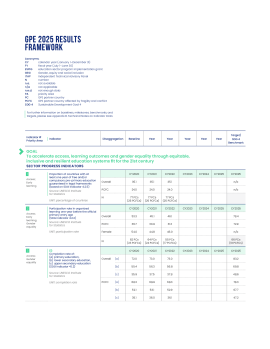GPE 2025 Results Framework
December 01, 2024
The Results Framework supports strategic decision-making and transparency by allowing the partnership to monitor progress in the main areas of its strategy. The Results Framework data below is as of September 2024. Also see GPE's Results Report 2024 for more information.
Sector progress indicators
Goal: To accelerate access, learning outcomes and gender equality through equitable, inclusive and resilient education systems fit for the 21st century
| Priority area | Indicator | |||||||||||||||||||||||||||||||||||||||||||||||||||||||||||||||||||||||||||||||||||||||||||||||||
|---|---|---|---|---|---|---|---|---|---|---|---|---|---|---|---|---|---|---|---|---|---|---|---|---|---|---|---|---|---|---|---|---|---|---|---|---|---|---|---|---|---|---|---|---|---|---|---|---|---|---|---|---|---|---|---|---|---|---|---|---|---|---|---|---|---|---|---|---|---|---|---|---|---|---|---|---|---|---|---|---|---|---|---|---|---|---|---|---|---|---|---|---|---|---|---|---|---|---|
| 1 |
Access Early learning |
Proportion of countries with at least one year of free and compulsory pre-primary education guaranteed in legal frameworks
|
||||||||||||||||||||||||||||||||||||||||||||||||||||||||||||||||||||||||||||||||||||||||||||||||
| 2 |
Access Early learning Gender equality |
Participation rate in organized learning one year before the official primary entry age
|
||||||||||||||||||||||||||||||||||||||||||||||||||||||||||||||||||||||||||||||||||||||||||||||||
| 3 |
Access Gender equality |
(i) Completion rate at primary, lower secondary and upper secondary age
|
||||||||||||||||||||||||||||||||||||||||||||||||||||||||||||||||||||||||||||||||||||||||||||||||
| 4 |
Equity, efficiency, and volume of domestic finance |
(i) Proportion of countries with government expenditure on education increasing or at 20% or above as a percentage of total government expenditure
|
||||||||||||||||||||||||||||||||||||||||||||||||||||||||||||||||||||||||||||||||||||||||||||||||
| 5 |
Gender equality Inclusion Strong organizational capacity |
(i) Proportion of women aged 20-24 years who were married or in a union before age 18
|
||||||||||||||||||||||||||||||||||||||||||||||||||||||||||||||||||||||||||||||||||||||||||||||||
| 6 |
Learning Gender equality |
Proportion of children and young people in Grade 2 or 3, at the end of primary education, and at the end of lower secondary education achieving at least a minimum proficiency level in reading and mathematics
|
||||||||||||||||||||||||||||||||||||||||||||||||||||||||||||||||||||||||||||||||||||||||||||||||
| 7 |
Quality teaching Gender equality |
(i) Proportion of teachers in pre-primary, primary, lower secondary and upper secondary education with the minimum required qualifications
|
||||||||||||||||||||||||||||||||||||||||||||||||||||||||||||||||||||||||||||||||||||||||||||||||
| 8 |
Strong organizational capacity Gender equality Inclusion |
(i) Proportion of countries reporting at least 10 of 12 key international education indicators to UNESCO Institute for Statistics
|
||||||||||||||||||||||||||||||||||||||||||||||||||||||||||||||||||||||||||||||||||||||||||||||||
Indicators on GPE country-level levers
Country-level objective 1: Strengthen gender-responsive planning, policy development for system-wide impact
| Priority area | Indicator | |||||||||||||||||||
|---|---|---|---|---|---|---|---|---|---|---|---|---|---|---|---|---|---|---|---|---|
| 9 |
Gender equality Strong organizational capacity |
(i) Proportion of countries that implement GPE allocation-linked policy reforms in the gender responsive sector planning and monitoring enabling factor as identified in their Partnership Compact
|
Country-level objective 2: Mobilize coordinated action and financing to enable transformative change
Country-level objective 3: Strengthen capacity, adapt and learn, to implement and drive results at scale
| Priority area | Indicator | ||||||||||||||||||||||||||||
|---|---|---|---|---|---|---|---|---|---|---|---|---|---|---|---|---|---|---|---|---|---|---|---|---|---|---|---|---|---|
| 14 |
All priority areas |
(i) Proportion of system transformation grants meeting specific objectives during implementation and that met objectives at completion (overall and by priority area)
|
|||||||||||||||||||||||||||
Indicators on GPE global-level levers
Enabling objective: Mobilize global and national partners and resources for sustainable results
| Enabling objective | Indicator | |||||||||||||||||||||||||||||||||||||||||||||||||||||||
|---|---|---|---|---|---|---|---|---|---|---|---|---|---|---|---|---|---|---|---|---|---|---|---|---|---|---|---|---|---|---|---|---|---|---|---|---|---|---|---|---|---|---|---|---|---|---|---|---|---|---|---|---|---|---|---|---|
| 15 |
Learning partnership |
(i) Number of cases of uptake of KIX-supported research, knowledge and innovation in country-level policy development or delivery through capacity
|
||||||||||||||||||||||||||||||||||||||||||||||||||||||
| 16 |
Strategic partnership |
(i) Number of GPE countries benefiting from newly mobilized technical assistance initiatives
|
||||||||||||||||||||||||||||||||||||||||||||||||||||||
| 17 |
Advocacy |
Number of countries where civil society in Education Out Loud-funded projects has influenced education planning, policy dialogue and monitoring
|
||||||||||||||||||||||||||||||||||||||||||||||||||||||
| 18 |
Financing |
(i) Percentage and (ii) cumulative amounts of donor commitments fulfilled |
Notes:
CY = calendar year (January 1-December 31)
FY = fiscal year (July 1 - June 30)
